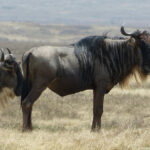Lions lazing in trees might sound like a scene from a fantasy novel, but it’s a captivating reality at Lake Manyara. Here, the remarkable phenomenon of tree-climbing lions draws tourists and researchers alike. It’s one of the few places on Earth where you can witness this unique behavior.
Lake Manyara National Park, established in 1960, provides a stunning ecosystem for these majestic creatures. Covering 325 square kilometers, the park is home to a variety of wildlife, but the lions are undoubtedly its star attraction. Statistics show that more than 300,000 visitors annually come to witness these arboreal acrobatics, a testament to the park’s allure and conservation success.

Exploring Lake Manyara: A Haven for Tree-Climbing Lions
Nestled in northern Tanzania, Lake Manyara National Park offers a unique adventure. It’s renowned for its tree-climbing lions, a rare behavior observed in few places worldwide. These lions ascend the acacia trees to escape the sweltering heat or annoying insects. This park, spanning over 325 square kilometers, presents a lush, tranquil environment contributing to this phenomenon.
The park’s rich biodiversity extends beyond the lions. Visitors can see elephants, buffalo, and hippos by the lake. Additionally, vibrant bird species such as flamingos and pelicans grace the water’s edge. The diverse flora and fauna make each safari excursion uniquely thrilling.
The reason behind these lions’ unusual behavior intrigues scientists. Some theories suggest it helps them avoid bites from ground insects. Others think it provides a vantage point for spotting prey. Regardless of the reason, seeing lions in trees makes Lake Manyara special.
Tourism positively impacts conservation efforts within the park. Revenue generated helps in protecting endangered species and maintaining the park’s infrastructure. Visitors keen on experiencing this marvel contribute to the ongoing preservation. This balance between tourism and conservation ensures Lake Manyara remains a haven for wildlife.
The Unique Behavior of Tree-Climbing Lions
Tree-climbing lions at Lake Manyara exhibit a truly unique behavior. Unlike their counterparts in other regions, these lions can be seen perched on branches. They often rest high in the acacia trees, a sight rarely encountered elsewhere. This behavior is believed to help them evade biting insects and enjoy cooler air. Researchers continue to study the reasons behind such intriguing patterns.
Watching these lions climb and relax in trees mesmerizes visitors. It’s not just a protection mechanism but also appears as a leisurely activity. This unusual habit sparks curiosity among animal behaviorists. Other areas report similar observations, but nowhere is it so prevalent as at Lake Manyara. This phenomenon adds a unique charm to the safari experience.
Several theories explain why these lions climb trees. One common idea points to avoiding ground-level pests. Another suggests they climb to escape the heat reflected off the savannah. These conflicting theories underscore the mystery surrounding this behavior. Whatever the reason, it offers a beautiful spectacle for wildlife enthusiasts.
Research shows these lions are healthy despite their unusual behavior. Climbers demonstrate agility and strong muscular coordination. Their tree-climbing skills do not compromise their hunting efficiency. Instead, it may even enhance their survival strategies. Lions at Lake Manyara, therefore, present a fascinating study in adaptation.
Wildlife Diversity in Lake Manyara National Park
Lake Manyara National Park boasts an incredible array of wildlife. Spanning across woodlands, grasslands, and swamps, it provides diverse habitats for many species. This variety of ecosystems supports elephants, giraffes, and buffalo. It’s a refuge for over 400 bird species, including flamingos and pelicans. Visitors are often treated to spectacular sightings throughout the park.
One of the park’s highlights is its large population of hippos. These massive creatures can be spotted lounging in the lake. The park also has numerous primates, including playful baboons and vervets. Moreover, elusive leopards make occasional appearances. This mix of animals ensures every safari trip offers something special.
Bird watching is particularly rewarding here. Enthusiasts can spot rare birds like the pink flamingo. Woodland kingfishers and crowned eagles are also found soaring above. Their vibrant colors and varied calls add to the park’s charm. The sheer number of bird species makes Lake Manyara a paradise for ornithologists.
The park’s dense population of predators includes lions and cheetahs. These majestic cats roam freely, hunting and interacting in their natural habitat. Conservation efforts have ensured their numbers remain stable. This makes Lake Manyara an essential destination for understanding Africa’s wildlife dynamics. Each visit contributes to the ongoing preservation of these magnificent creatures.
Conservation Efforts and Tourist Impact at Lake Manyara
Lake Manyara National Park benefits greatly from conservation initiatives. These efforts focus on protecting diverse wildlife and rich vegetation. Park authorities implement measures to counteract poaching and habitat destruction. Success in these areas ensures the park remains a safe haven for many species. Conservation partnerships also aid in educational programs.
Tourism plays a significant role in these conservation efforts. Visitors contribute to the park’s revenue, directly supporting maintenance and protection. The funds help improve infrastructure and research projects. Tourists provide essential financial backing, making conservation sustainable. Their presence is vital for ongoing preservation activities.
To minimize negative tourist impact, strict guidelines are enforced. These include designated paths and limits on vehicle numbers. They help maintain the park’s natural integrity. Eco-friendly practices are encouraged to reduce waste and disturbances. These regulations ensure both wildlife and visitors are protected.
Educational programs are crucial to promoting conservation awareness. Visitors can join guided tours focusing on environmental impact and wildlife preservation. These tours provide engaging insights into the park’s ecosystem. Learning about conservation efforts fosters a deeper connection. It encourages tourists to support responsible practices.
Despite tourism’s benefits, it also brings challenges. High visitor numbers sometimes lead to habitat disturbance. Continuous monitoring helps manage this impact. Strategies include rotating safari routes and enforcing visitor caps. Balancing tourism and conservation is an ongoing effort. However, the commitment to preserving Lake Manyara remains strong.
Local communities play an important role in these initiatives. They participate in sustainable projects around the park. These projects benefit both the ecosystem and the local economy. Engaging locals ensures a holistic approach to conservation. Their involvement is a key factor in Lake Manyara’s success.















